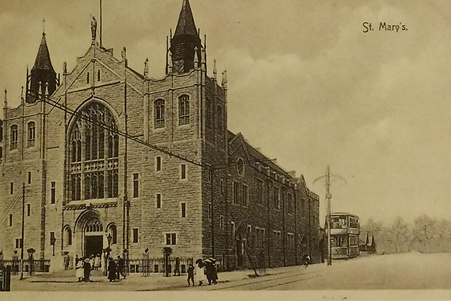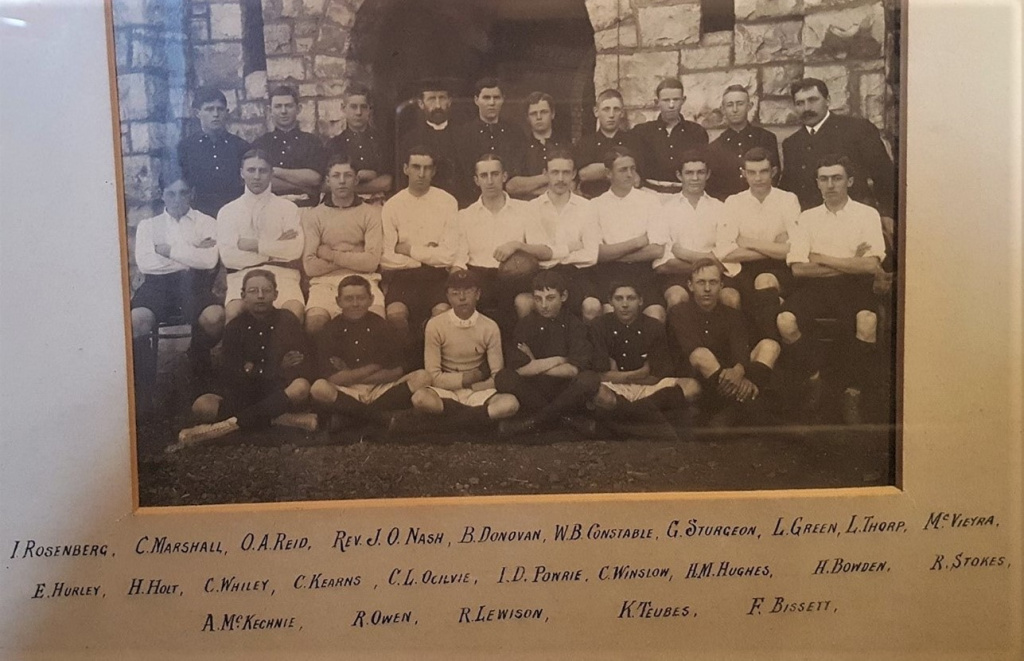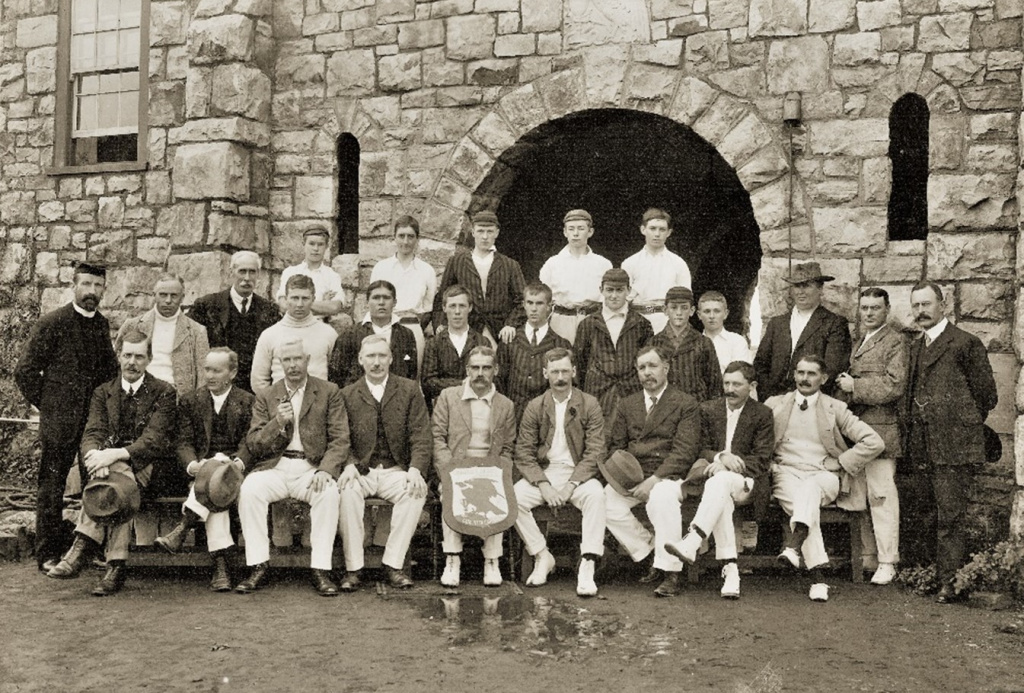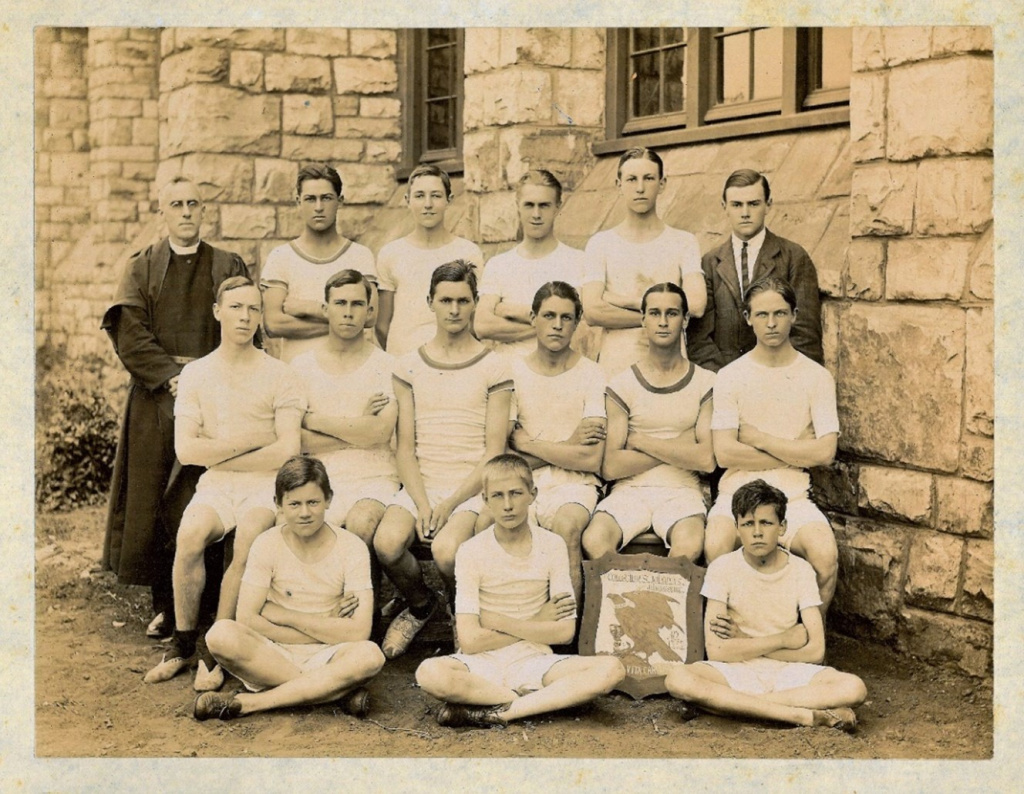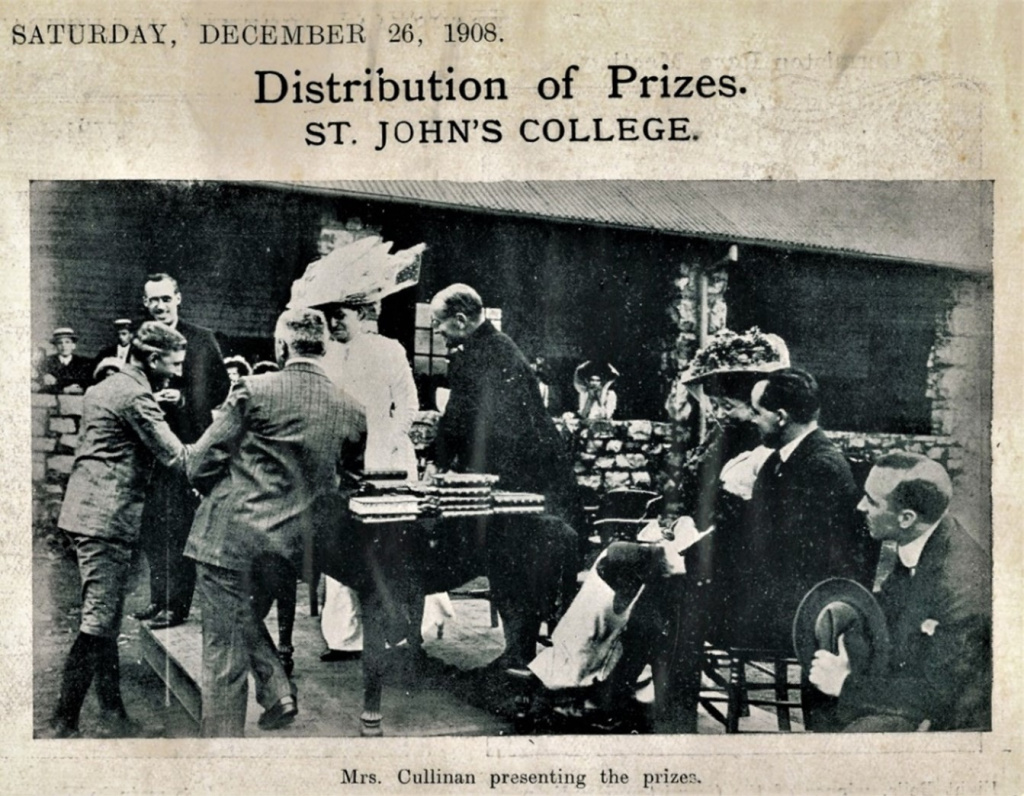by Dr Daniel Pretorius, Chairman of the Heritage Committee
At the beginning of Lent Term, 38 new boys entered St John’s College, bringing the total enrolment to 123. Thus, enrolment numbers had trebled since the Community of the Resurrection had taken charge of the school two years earlier. Fr Nash announced that the school had acquired a telephone but he dissuaded parents from calling the school unnecessarily. At any rate, he made it clear that parents should not expect calls to be answered during the course of the school day: ‘it is impossible for us to attend to it in school hours,’ he wrote in the Letter of Lent Term. ‘It is not right to leave a whole class of boys waiting, in order to listen to some perhaps not very important message.’ From this we can infer that, apart from the C. R. fathers themselves, the school had no staff to attend to seemingly mundane matters such as answering the telephone.
Fr Nash also wrote that the results achieved by the boys who had written the Cambridge Preliminary examination at the end of 1907 were ‘very satisfactory’. St John’s was the only school in the Transvaal that entered students for this examination, which was taken by some 5,000 boys and girls all over the British Empire. Other schools in South Africa that did so included Michaelhouse and Hilton College (‘schools very much of our sort, though all boarding schools’). Nine of the fourteen St John’s boys who sat the exam passed the requisite minimum of six subjects. In the under 14 division, Percy Webster (Rakers) passed in seven subjects: English History, Arithmetic, Dictation, English (grammar, literature and composition), Religious Knowledge, Latin and French. In the under 16 division, William Hortor (Thomson), Emmanuel Jacobson (Alston) and Oswald Reid (Thomson) passed in eight subjects each. Fr Nash added, however, that education means more than passing examinations: ‘It is much more important to interest a boy in a subject and give him a desire to know it.’
Fr Nash expressed the view that St John’s boys ‘should begin to learn to have sympathy with the sick.’ For that reason, on Lady Day (25 March, when the Feast of the Annunciation is celebrated) three dozen boys had ‘made a great expedition’ to the lazaretto at Rietfontein. The lazaretto (situated near modern-day Edenvale) was a hospital where patients with contagious diseases, such a leprosy and smallpox, were quarantined. There the St John’s boys had given a concert to the ‘chronic sick’, and had also had an opportunity to enjoy themselves – ‘what with Dr Mehliss’ swimming bath and quinces, and the nurses’ tea.’ Dr Mehliss was the superintendent of the lazaretto.
On either side of the Lady Day excursion, St John’s boys attended special services at St Aidan’s Church, Yeoville, on Ash Wednesday (4 March) and at St Mary’s Church in the city centre on Maundy Thursday (16 April). To enable the boys to attend the latter service, the Rector of St Mary’s and founder of the College, the Revd Mr Darragh, had arranged a special tram to transport them from Houghton to the school’s historical and spiritual place of origin. By 1908, however, the original St Mary’s Church (where Darragh and the first Headmaster, the Revd Mr Hodgson, had initiated the establishment of the College) had been demolished and replaced by the new St Mary’s Hall. This was where the St John’s boys went for the Maundy Thursday Mass.
The Headmaster reported that construction of the school’s new chemistry laboratory, designed by ‘our architect’, Mr Herbert Baker, was in the process of being completed, at a cost of £600. The laboratory, officially opened on Ascension Day by John Yates (Professor of Mining and Metallurgy at Transvaal University College), boasted apparatus worth ₤150 purchased with a bequest made by the mining magnate Alfred Beit. Lord Selborne had donated £20 to the laboratory fund, while Lady Selborne, having observed that St John’s lacked a flagstaff, had kindly offered to donate one. ‘And it was a real pleasure when Lady Selborne drove over one afternoon … to inspect the school.’
Fr Nash also mentioned that St John’s had resisted overtures made by the Director of Education to the school to suppress itself in favour of undenominational state schools. (By contrast, St Birinus Diocesan School in Pretoria was unable to resist the pressure and was taken over by the government and converted into a non-denominational school.) Nash had hoped that the idea of placing Johannesburg College ‘next door to us’ had been abandoned after the Secondary Education Commission had reported in favour of the Smit Street site for Johannesburg College and the government had accepted that recommendation. However, it now appeared that this ‘threat has been renewed.’ He regarded this prospect as a ‘disaster’, as ‘such close rivalry will be injurious to both schools.’ But St John’s would put up a good fight to maintain a church school ‘even against the long purse of government’:
‘We believe ... that the supreme end of education is the training of character. And we believe that the most powerful agency for the influencing of character and morals is religion. And we believe that religion to be effective must be taught as systematically and definitely as any other subject – arithmetic, Latin or chemistry – and moreover by those who believe in it and study it. … There then is the great cause for which our small school of St John’s stands. … If we keep true and faithful we may hope to stand even against great difficulties.’
Meanwhile, the College 1st XI had been ‘very fair’ during Lent Term. The arrival of ‘two good cricketers, Isidore Rosenberg and George Sturgeon, made it quite strong’. Considering that St John’s played against stronger teams than ever before, including senior men’s teams that contained good players, the College had ‘done very creditably.’
St John’s lost to the Bank of Africa XI. The match against Mr E. R. Sturgeon’s XI (which included the leg-spinner S. J. Pegler, who would go on to play sixteen Test matches for South Africa) was also lost. For St John’s, Oswald Reid (Thomson) scored 32 and Ronald Owen (Alston) made 21.
There was also a defeat to the Bishop of Pretoria’s XI (which included not only the College’s former Headmaster, the Revd Mr Carter, but also W. A. Shalders, who had played twelve Test matches for South Africa). The Bishop made the match popular among the St John’s boys by requesting a half-holiday, ‘and the Visitor of our College may not be refused,’ said Fr Nash. St John’s scored only 102 (‘some of the boys batted admirably but they have a lot to learn in the art of running and backing up’) but kept themselves in contention by reducing the Bishop’s XI to 66/5. There was ‘great rejoicing when Shalders was caught at the wicket for 19.’ However, Mr Scully scored 67, thereby securing victory for His Grace’s men. George Sturgeon (Rakers) took 4/51 and Isidore Rosenberg (Thomson) 4/69. St John’s also lost, by seven runs, to a team called ‘The Frogs’. In this match, Basil Roseveare (Thomson) scored 41 for St John’s, while Rosenberg contributed 38.
However, these defeats did not detract from a reasonably successful season. Guided by the ‘skilled instructor’, Mr Alfred Atfield, St John’s defeated Pretoria Diocesan School by an innings and 114 runs (Roseveare 67*, Sturgeon 54 and 3/7, Brown-Constable 39, Harry Marsh 39*, Rosenberg 5/17 and 6/23) at the Pretoria Caledonian Ground on 24 February. There were also victories over Jeppe by 86 runs (Rosenberg 75), over Rosettenville by 109 runs (Sturgeon 36, Donovan 22), and over Wanderers Juniors by four runs (Donovan 35).
The match against Marist Brothers’ College was drawn, Owen scoring 32. So too was the match against Mr Mullen’s XI, which included A. B. Tancred, who had played in South Africa’s very first two Test matches, in 1888/’89. According to Wisden, Tancred had been ‘undoubtedly the finest batsman in South Africa’ for ten years. On this occasion, however, he scored only 21 (although it must be said that he was by now 43 years old). For St John’s, Sturgeon made 40*, Reid 38 and Roseveare 37.
Matches against the English Church Men’s Society (against whom Rosenberg scored 61), a Clergy XI (for whom the former Headmaster, the Revd Mr Carter, scored 63, while Sturgeon scored 45 for St John’s) and Old Johannians were also drawn. In the Past v Present match, St John’s scored 175 (Sturgeon 45, Reid 40) and the O. J.s 128/4 (Troye 53, Reid 40).
Rosenberg, Sturgeon, Roseveare, Donovan, Owen and Marsh all played for Johannesburg Schools against Mr Abe Bailey’s XII (which included the Springboks R. O. Schwarz, A. E. Vogler and E. A. ‘Barberton’ Halliwell) at the Wanderers on 19 February. The Schools team batted first and scored 228. Mr Bailey’s XII scored 203/8. Rosenberg (‘who should drop the habit of bowling with a loose sleeve’) had figures of 10-1-24-2, and won the prize for the best bowling in the match.
Rosenberg played club cricket for Wanderers III. He opened the batting for the composite Johannesburg third-league team in the annual inter-league match against their counterparts from the combined Pretoria clubs. After the Johannesburg juniors had been reduced to 47/4, they recovered well to reach 234/7. ‘The main contributor was I. Rosenberg, of the Wanderers and St John’s College, who compiled 120 not out by really good cricket,’ the daily press enthused. ‘A left-hander, he stands well up at the wicket, and plays in nice easy style, and is particularly strong on the off-side. He played wonderfully sound cricket, and ... his play was quite a class by itself, and showed him to be the best bat on the side. If he only maintains the promise he now gives he ought to become one of the best left-hand batsmen the Transvaal has known, for he plays very correct cricket.’
The St John’s College 2nd XI played against the Railway Lads twice, winning once and losing once, and also lost to Jeppe’s 2nd XI, Volunteer Juniors and Johannesburg College’s 3rd XI. The St John’s 3rd XI won against St Augustine’s Choir but lost to Jeppe and to Troyeville Grammar School. The juniors won against Johannesburg College, and won once and lost once against Park Town School.
Fr Nash wrote his Letter of Easter Term while aboard the German East Africa steamer Windhuk. He was ‘homeward bound’: ‘Our Community requires us all to come home on furlough after a term of years.’ He had delayed his departure until a suitable substitute teacher had been secured. Now he could go with equanimity as his classes would be in the good hands of Mr T. Henderson M. A. (St John’s College, Cambridge), who had previously taught classics and English at Marist Brothers’ College.
The highlight of the Easter Term football season had been the Old Boys’ Match, played on Ascension Day (28 May). The Past v Present match had also been played on Ascension Day in 1907, and Fr Nash expressed the hope that this would become an annual event. (As it transpired, this event soon developed into the annual Gaudy Day.) On this occasion, the Old Boys’ team consisted of: Charles Ogilvie (captain), R. Stokes, John Powrie, Colin Kearns, Cecil Whiley, Hugh Maxwell Hughes, Frank Bissett, Harold Holt, Charles Winslow, Harry Bowden and Ernest Hurley. The game was ‘keen and fast’. Winslow soon scored for the Old Boys (‘we could forgive a goal to the Champion Lawn-tennis player of South Africa’, wrote Fr Nash). When the Old Boys took a 2-0 lead, the boys, captained by Bennett Donovan (Alston), woke up, got a goal, and then equalised. Ultimately, though, the Old Boys won a most enjoyable game by 3-2.
Whereas the College’s under 13 team had come second in the Johannesburg league in 1907, this football season was more challenging. The under 19 team lost to Marists (0-2) and to Johannesburg College (0-5), but beat Jeppe (4-3). The under 15A team failed to win a game. The under 13A team, captained by Hyman Patlansky (Nash), beat Johannesburg College twice (3-2 and 2-1), drew with Jeppe, and lost to Marists (0-5).
On 25 June 1908, the end-of-term ‘breaking up entertainment’ was held. There was ‘a great crush’ as people flocked to the school to see scenes from Shakespeare’s Henry V. The previous Saturday the cast had gone out to the lazaretto for a dress rehearsal staged for the benefit of the patients. Now, at the performance proper, ‘all through the scenes went brightly, and delighted the audience.’ Fr Nash wrote: ‘A play like this certainly takes a lot of time and trouble; but it is a great education and pleasure to the boys.’
For the duration of Trinity and Advent Terms, Fr Nash was on furlough in England (where he visited schools such as Radley and Repton). Fr Thomson deputised for Fr Nash, who wrote that his work at St John’s was to him ‘a great happiness, and I believe God-given: and I shall be glad to get back to it.’
In August and September, a measles epidemic swept through the Witwatersrand. The authorities closed many schools. It was hoped that St John’s, by reason of its salubrious location, might be spared. Alas, wrote Fr Thomson, ‘we have not quite escape scot-free.’ A young boarder developed the disease on 29 August, and another six cases appeared during the following fortnight. The school doctor, Dr Carlyon, and the Medical Officer of Health concurred that the situation did not warrant the closing of the school. Nevertheless, Fr Thomson said that he would not hesitate to do so if it seemed desirable. Ultimately, that proved unnecessary. ‘When an epidemic is rife,’ commented Fr Thomson, ‘we in our fine open breezy position have a better chance of escaping its ravages than most schools.’
In Fr Nash’s absence, there was a great deal of activity at the College. At the second athletic sports day, held on 12 September, Bennett Donovan (Alston) was crowned victor ludorum and received a ‘handsome gold medal’ donated by the Old Boys’ Association; Isidore Rosenberg (Thomson) was the runner-up. Regrettably, though, none of the St John’s athletes excelled at the Inter-High School Sports, held at the Wanderers on 23 September ‘in cold, drizzling, cheerless weather, before a small attendance of brave parents and friends.’ The championship was easily secured by Johannesburg College.
By contrast, the gymnastic display held at the Wanderers a few days earlier to mark the club’s twentieth anniversary had taken place on a beautiful spring day and had attracted crowds of spectators who lined the rim of the ground and filled the stands. A thousand boys and girls, wearing their distinctive school colours, participated in the display. The ‘wonderful precision and grace of the various movements pleased people immensely,’ wrote Fr Nash.
The St John’s Old Boys’ Association held their first annual dinner on the evening of 12 September 1908 – ten years after the founding of the College. The event, arranged by Mr C. L. Ogilvie (the Association’s honorary secretary and treasurer), took place at the stately Luthje’s Langham Hotel in Kerk Street, and was attended by ‘nearly thirty’ old boys. The Chairman of the College Council, the Venerable Archdeacon Furse, presided. He exhorted the Association to ‘be vigorous and strong, always prepared to lend a helping hand to the School. The Council and the masters … need the staunch support of parents and friends – and particularly of Old Boys.’ Afterwards, Fr Thomson commented: ‘Again and again the Old Boys have given a helping hand to their old school … and we are confident that they will in future take every opportunity of showing their practical interest in the school and giving it many a push on.’
Fr Thomson also reported that the Lower School had grown so much in recent times that Mr Wilfrid Brown-Constable O. J. (‘not only a good scholar but a capital athlete’) had been appointed to assist Mr Call-Weddell in teaching the younger boys. It was most important, observed Fr Thomson, ‘that the Upper School should be “fed” with well-trained boys from the Lower School.’ He concluded by emphasising that the aim of St John’s College was expressed in the school prayer: that it may be ‘a home of religious discipline, sound learning and goodwill, which may send forth many rightly trained in body, mind and character to serve God well in Church and Commonwealth.’
By Advent Term, there were 135 boys at St John’s. In his terminal letter, the acting Headmaster noted various activities: weekly swimming lessons took place at the Orange Grove baths; the Debating Society had hosted debates on motions such as ‘Conscription in S. Africa’ (carried by a small minority) and ‘Abolition of Capital Punishment’ (‘the hangman at Pretoria may feel relieved to know that he is in no danger or retrenchment’); and the expansion of the school library which, ‘though it contains a good many nice books’ (including the full works of Scott and Dickens, as well as many of the writings of Thackeray, Kipling etc) nevertheless ‘stands badly in need of some more recruits to swell its somewhat thin ranks.’ In this regard, Fr Thomson observed: ‘One is often struck with the lack of general reading amongst the boys; no doubt this is partly accounted for by the open air life led in this country; but a good deal more general reading would be of the greatest advantage to boys.’
Cricket suffered badly from adverse weather, with several matches having to be abandoned. One of the matches that had to be called off due to rain was that against Mr Given-Wilson’s XI, which contained ‘the great Vogler and other S. African players’. (The leg-spinner A. E. E. ‘Bert’ Vogler played fifteen Tests, taking 64 wickets, for South Africa between 1905/’06 and 1910/’11. He was a Wisden cricketer of the year in 1908.)
The 1st XI only managed to win two matches. The first of these was played in ‘stormy weather’ against the Fathers (captained by Mr W. H. Greathead, who had played for Transvaal against R. G. Warton’s English team in 1888/’89). The boys ran up 156 before dismissing their elders ‘in cavalier fashion’ for 28. The second victory came against a weak Clergy XI on a wet day. The Clergy scored 107 all out, and St John’s then made 124/6.
The matches against the ‘powerful’ Johannesburg College, Bank of Africa and the Old Boys were lost. The Old Boys disposed of the College XI for 82 and then made 131/6. The match against Jeppe ended in a draw in their favour; Harry Marsh (Rakers) took four wickets and Oswald Reid (who ‘hit out recklessly at everything’) scored 43 runs.
The 2nd XI defeated the Cadets, Poultney’s XI, Derby Cricket Club (twice) and East Rand Juniors, drew with Jeppe and Volunteers Juniors, and also lost a match against the latter. The 3rd XI beat St Augustine’s Choir, Jeppe, Troyeville Grammar School and Bellevue Cricket Club. The ‘small boys’ lost to Park Town School.
At the end of November 1908, a Johannesburg Schools team played against a Transvaal Cricket Union XI. The Schools team comprised boys from Johannesburg College, Jeppestown, St John’s, Marist Brothers’ and Park Town School. The St John’s boys selected for the team were Oswald Reid, Bennett Donovan, Ronald Owen, Leslie Green and Harry Marsh.
Speech Day took place on 18 December 1908. There was a large gathering of parents and friends at four o’clock, when ‘tea was bountifully provided by the Mothers and other Ladies.’ In the big school room (which was ‘filled to overflowing’) the boys sang a selection of songs they had learnt during the year. After the concert, all trooped out into the open School Court-Yard, where the Bishop was in the chair and Mrs Cullinan, ‘whose name is very closely identified with the welfare of S. John’s, graciously distributed the prizes.’ Among the recipients of prizes were O. Reid (Form V prize for Divinity); L. Thorp (Form V prize for English); R. Owen (the Good Fellowship prize, given by the Old Boys’ Association and balloted for by the Upper School); I. Rosenberg (Mathematics Prize); F. van den Berg (Gold Medal for Latin); and H. Marsh (Dutch prize).
Principal sources:
JAI Agar-Hamilton Transvaal Jubilee: A History of the Church of the Province of South Africa in the Transvaal (1928); KC Lawson Venture of Faith: The Story of St John’s College, Johannesburg (1968); National Archives of South Africa TAB CS 860 14792; P Venter ‘Die groei van onderwysaangeleenthede in Johannesburg, 1886-1920’ (PhD thesis, Potchefstroom University, 1950)
The Star 13 February 1908, 27 March 1911, 19 December 1908; Rand Daily Mail 13 February 1908, 15 February 1908, 25 February 1908; Transvaal Leader 13 February 1908, 19 February 1908, 20 February 1908, 29 March 1908; Transvaal Weekly Illustrated 12 October 1907, 29 February 1908, 28 March 1908, 4 April 1908, 5 October 1908, 17 October 1908, 21 November 1908; Jeppestown High School Magazine June 1908 and December 1908
St John’s College Letter of Lent Term 1908; Letter of Easter Term 1908; Letter of Trinity Term 1908; Letter of Advent Term 1908

